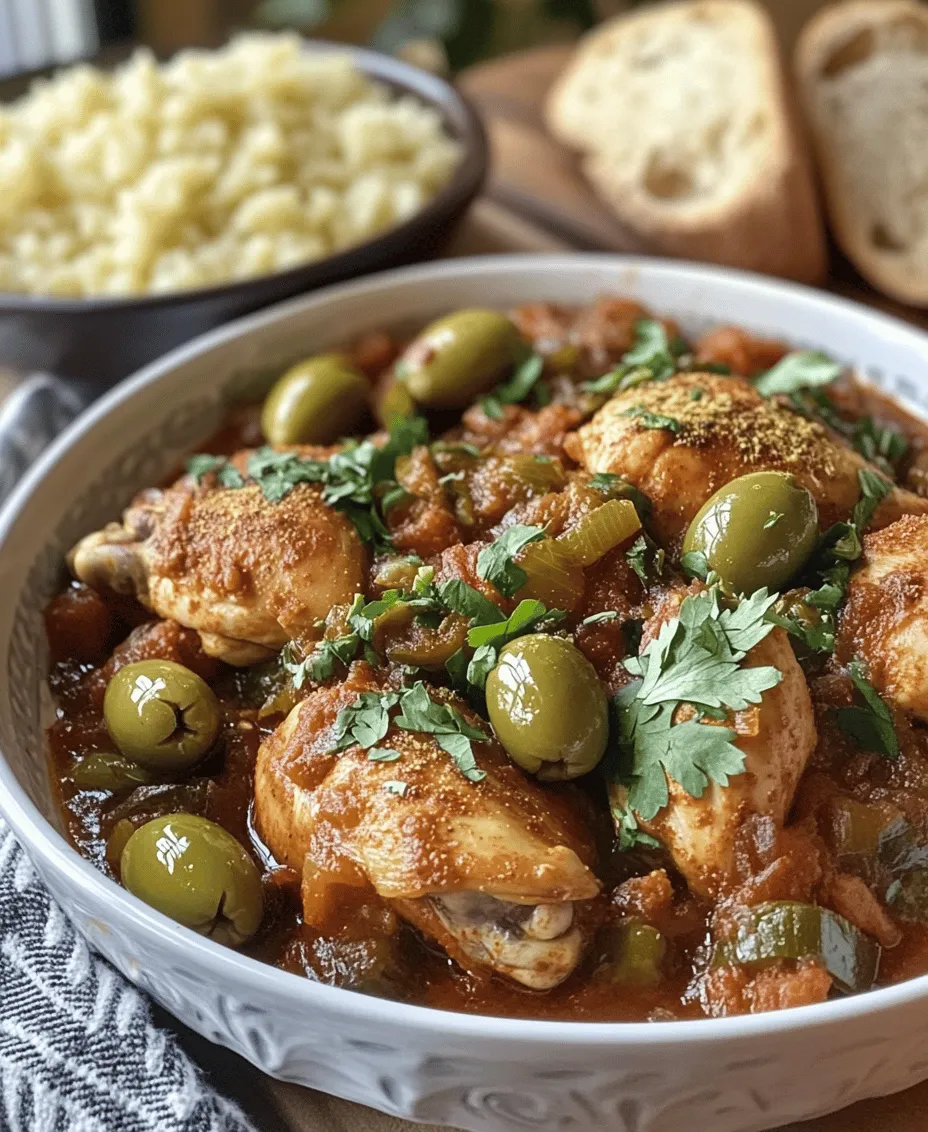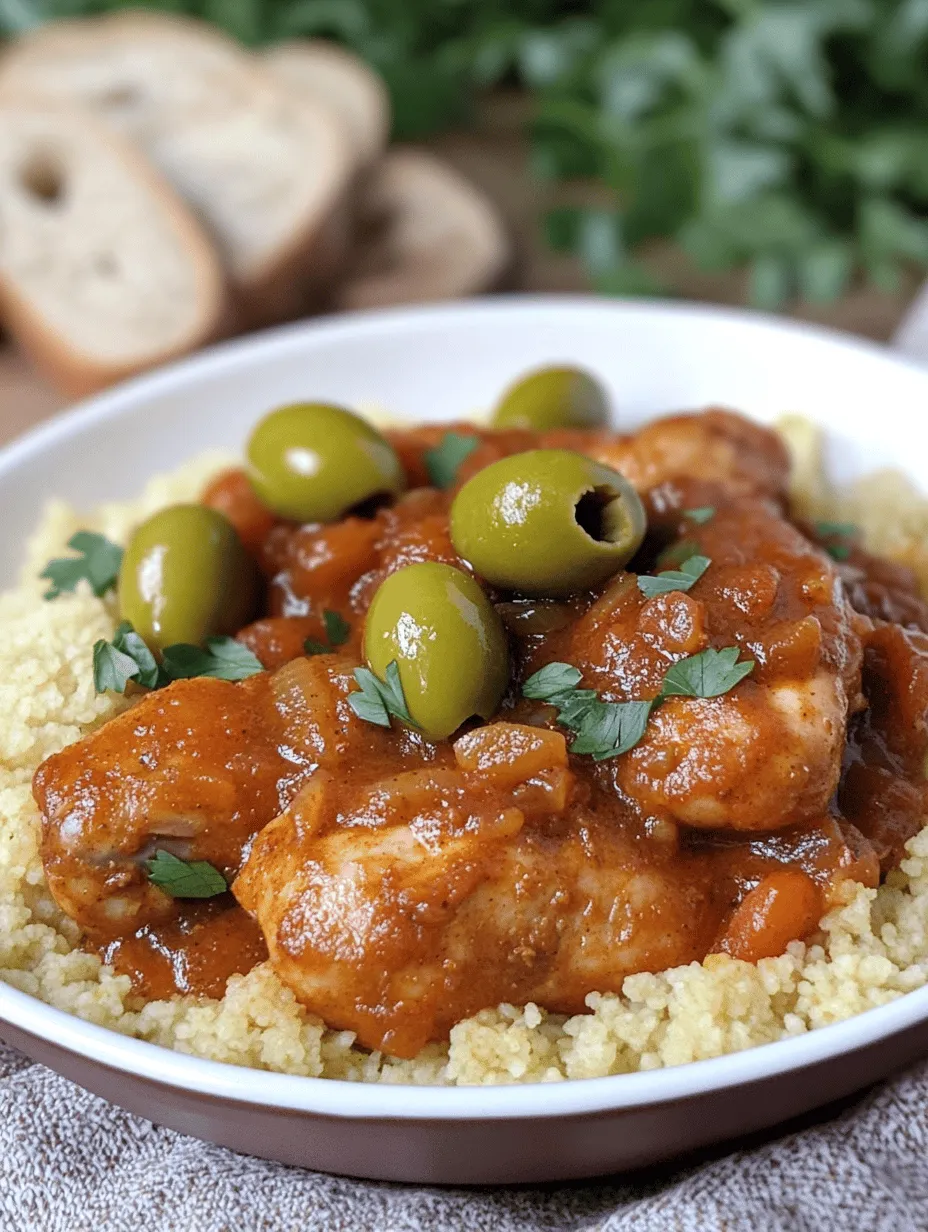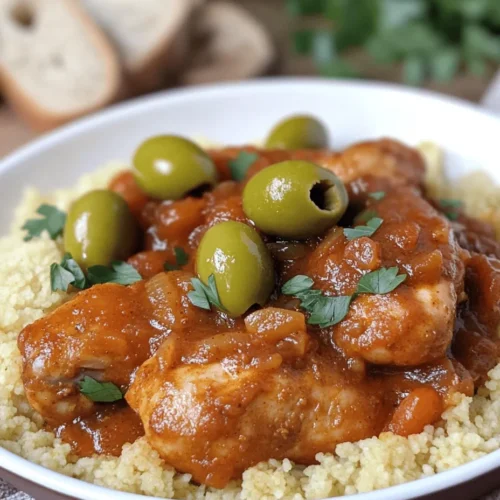Introduction
Moroccan cuisine is celebrated for its vibrant flavors, aromatic spices, and colorful presentations. At the heart of this culinary tradition lies the tagine, a slow-cooked stew named after the earthenware pot in which it is cooked. This traditional dish is a staple in Moroccan households, showcasing the rich agricultural bounty of the region. Among the many variations, the Zesty Chicken Tagine with Olives and Lemons stands out for its bright, invigorating flavors and the perfect balance of savory and tangy notes.
This specific recipe for Zesty Chicken Tagine highlights the unique combination of tender chicken thighs, briny olives, and preserved lemons, creating a dish that is as delicious as it is visually appealing. It’s a perfect representation of Moroccan cuisine, marrying the essence of fresh ingredients with the depth of traditional spices. The beauty of this dish lies not only in its taste but also in its versatility—it can be served as an elegant centerpiece for a dinner party or a comforting family meal during the week.
Using fresh ingredients is crucial for achieving the authentic flavors associated with Moroccan cooking. Each component plays a significant role, from the succulent chicken to the zesty preserved lemons that add a unique brightness. This recipe encourages home cooks to embrace bold flavors and explore the depths of Moroccan culinary traditions.
Understanding Tagine Cooking
The tagine cooking method is defined by the unique shape of the tagine pot itself, which consists of a flat, circular base that is topped with a conical lid. This design is not merely aesthetic; it serves a functional purpose by trapping steam and allowing for an even distribution of heat. The result is a tender, flavorful dish that benefits from slow cooking, which can take anywhere from one to three hours depending on the ingredients used.
Historically, tagines have been a staple of Moroccan cuisine for centuries, with their origins tracing back to the Berber people of North Africa. The method was developed as a way to create hearty meals using simple ingredients, often cooked over an open flame. This cooking style allows for the melding of spices and flavors, resulting in dishes that are deeply satisfying.
One of the many benefits of slow cooking in a tagine is the enhancement of flavors and tenderness of the meat. As the chicken simmers, it absorbs the aromatic spices and the natural juices from the vegetables, creating a rich and complex flavor profile. This method also allows for the development of a sauce that can be used to drizzle over couscous or served with crusty bread to soak up every last drop.
Ingredients Breakdown
To create a memorable Zesty Chicken Tagine, it’s essential to understand the role of each ingredient in the recipe. The following is a detailed breakdown of the key components that bring this dish to life:
Chicken Thighs
Using chicken thighs instead of breasts is a game-changer in this recipe. Thighs are more flavorful and tender, especially when cooked slowly, making them an ideal choice for tagine. They also retain moisture better than chicken breasts, resulting in juicy pieces of meat that are packed with flavor. Additionally, chicken thighs are a healthier option, providing a good source of protein and essential vitamins.
Spices
The heart of Moroccan cooking lies in its spices. For this Zesty Chicken Tagine, you will typically use a blend of ground cumin, coriander, ginger, cinnamon, and turmeric. Each spice contributes distinct flavors, creating a warm and aromatic base. Cumin and coriander provide earthiness, while ginger adds a touch of warmth. Cinnamon lends a subtle sweetness, and turmeric offers a vibrant color and anti-inflammatory benefits.
Olives
Olives are a quintessential ingredient in Moroccan cuisine, adding a briny depth that complements the sweetness of the other ingredients. For this recipe, green olives are preferred for their robust flavor, but black olives can be used for a milder taste. Look for high-quality olives, ideally from a local market or specialty store, to ensure the best flavor.
Preserved Lemons
One of the stars of this dish is preserved lemons, which are lemons that have been cured in salt and their own juices. They offer a unique combination of salty, tangy, and slightly sweet flavors that are irreplaceable in Moroccan cooking. Their intense flavor enhances the dish, making it bright and refreshing. If you cannot find preserved lemons, you can make your own by placing lemons in a jar with salt and allowing them to cure for several weeks.
Aromatics
Onions and garlic are essential to building the base flavor of the tagine. Sautéing these aromatics releases their natural sweetness and enhances the overall depth of the dish. They provide a savory foundation that complements the spices and other ingredients beautifully.
Fresh Herbs
Finally, fresh herbs such as cilantro or parsley are often used to garnish the finished dish. They add a burst of freshness and color, brightening up the rich, savory tones of the tagine. Herbs also provide additional nutritional benefits, as they are rich in antioxidants and vitamins.
In sourcing these ingredients, it’s best to look for local markets that specialize in Mediterranean or Middle Eastern foods. Fresh produce, high-quality spices, and authentic preserved lemons can often be found in specialty grocery stores or farmers’ markets, ensuring that your dish is as flavorful and authentic as possible.
Preparation Steps for Zesty Chicken Tagine
With a solid understanding of the ingredients, it’s time to delve into the preparation steps that will lead you to a delicious Zesty Chicken Tagine. The following step-by-step breakdown will guide you through the cooking process, ensuring you achieve the best results.
Step 1: Preparing the Ingredients
Before you begin cooking, it’s essential to prep all your ingredients. Start by chopping the onions and mincing the garlic. Next, cut the preserved lemons into quarters, removing any seeds, and slice the olives if they are whole. This preparation will streamline the cooking process and ensure you have everything on hand when needed.
Step 2: Browning the Chicken
One of the crucial steps in making a flavorful tagine is properly browning the chicken. Heat a generous amount of olive oil in the tagine pot or a heavy-bottomed Dutch oven over medium-high heat. Once the oil is hot, add the chicken thighs, skin-side down, and sear them for about 5-7 minutes until they are golden brown. This step locks in the juices and flavor, creating a delicious crust.
After browning, remove the chicken from the pot and set it aside. This will allow you to sauté the onions and garlic in the same pot, taking advantage of the flavorful bits left behind.
Step 3: Sautéing Aromatics
With the chicken set aside, add the chopped onions to the pot, stirring to incorporate the leftover juices. Sauté the onions for about 5 minutes until they become translucent. Then, add the minced garlic and continue to sauté for an additional minute, being careful not to let it burn. This combination of aromatics will form the flavor base of your tagine.
Step 4: Adding Spices and Chicken Back to the Pot
Once the onions and garlic are fragrant, it’s time to add the spices. Sprinkle in the cumin, coriander, ginger, cinnamon, and turmeric, stirring well to coat the onions and garlic. Toasting the spices for a minute will enhance their flavors, releasing their natural oils and aromas.
After the spices have been incorporated, return the browned chicken thighs to the pot. Nestle them among the aromatics, ensuring they are well-coated with the spice mixture. This step is crucial for infusing the chicken with those distinct Moroccan flavors.
Step 5: Incorporating Olives and Preserved Lemons
Next, add the sliced olives and preserved lemons to the pot. Pour in enough water or chicken broth to cover the chicken halfway, allowing the flavors to meld as the tagine cooks. The liquid will create a rich sauce that serves as the base for the dish, enhancing the overall taste.
Once everything is in the pot, bring the mixture to a gentle simmer. Cover the tagine with its lid, reducing the heat to low, and allow it to cook slowly for about 1.5 to 2 hours. During this time, the chicken will become incredibly tender, and the flavors will deepen, resulting in a deliciously aromatic dish.
Step 6: Final Touches and Serving
As the tagine finishes cooking, it’s essential to check on it occasionally. If the sauce becomes too thick, add a splash of water or broth to maintain a saucy consistency. When the chicken is tender and easily pulls away from the bone, it’s time to serve.
For an authentic Moroccan experience, serve the Zesty Chicken Tagine with fluffy couscous or crusty bread, allowing guests to soak up the delicious sauce. Garnish with freshly chopped cilantro or parsley for an added touch of color and flavor.
With these preparation steps in mind, you can create a stunning Zesty Chicken Tagine that will impress family and friends alike. The combination of tender chicken, vibrant spices, and the tangy punch of olives and lemons makes this dish a perfect representation of Moroccan culinary artistry.




